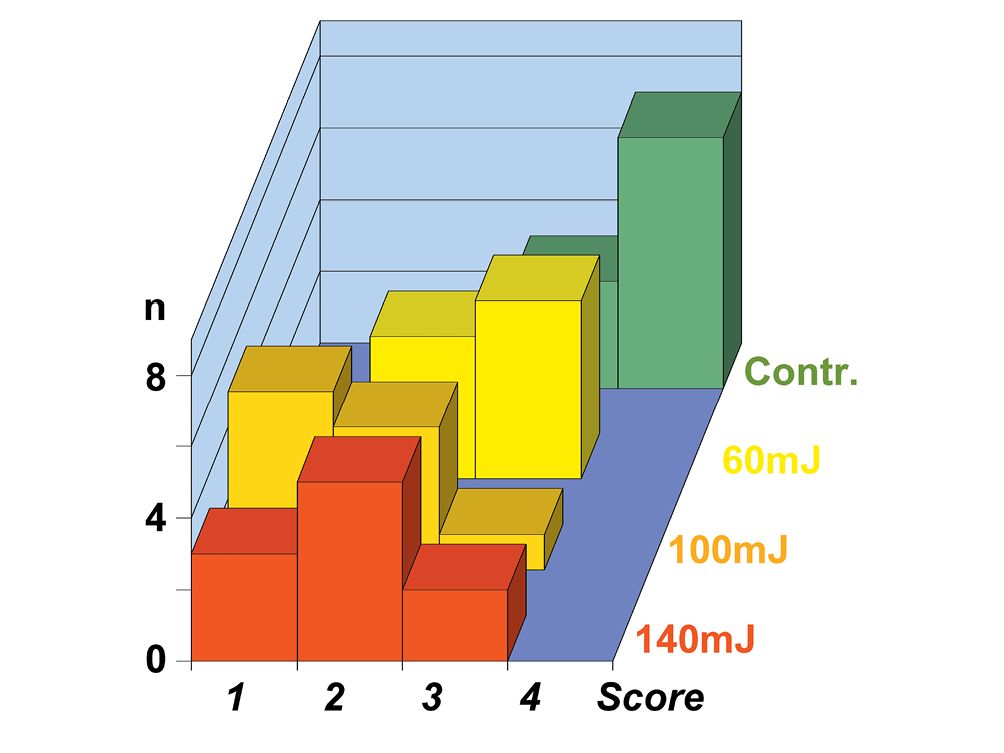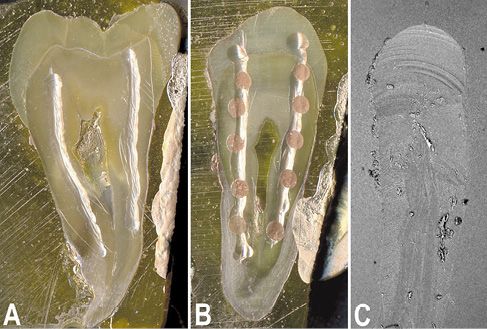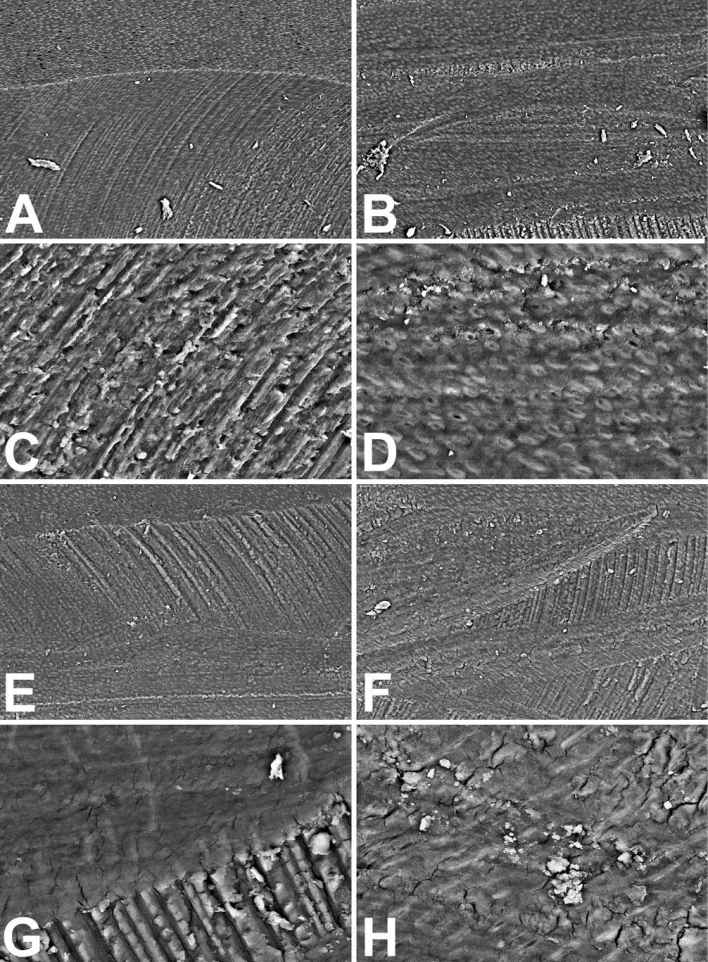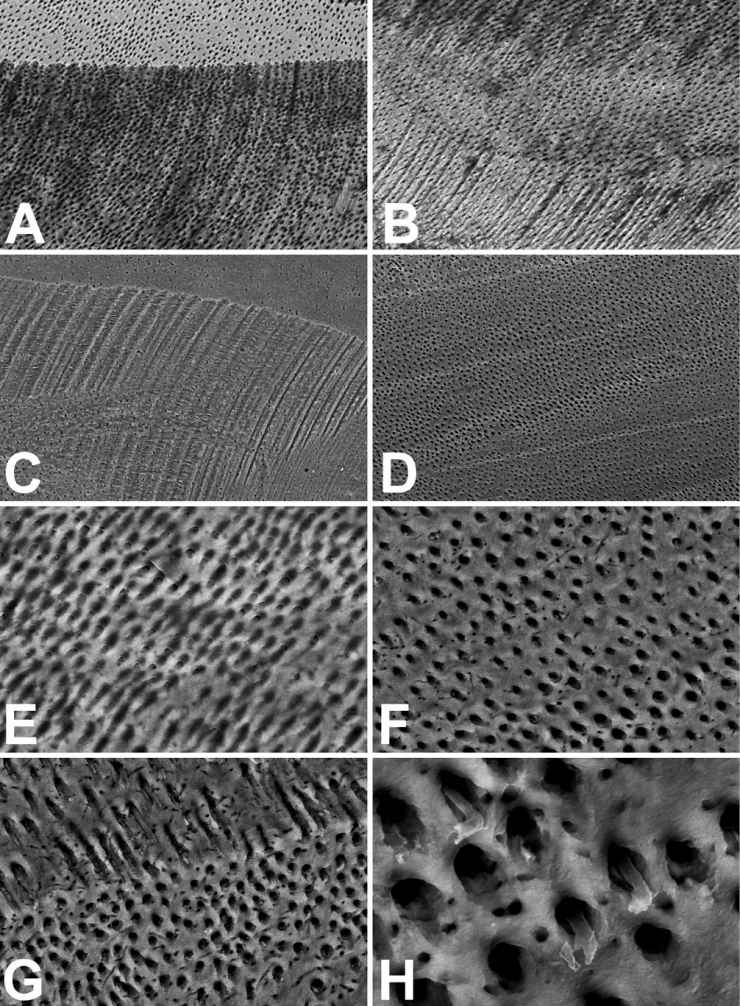Microscopy of laser effects on hard and soft oral tissues
Davide Zaffe, Annibale Renzo Botticelli, Marina Consuelo Vitale, Cesare Piacentini
Lasers are instruments generating high-power electromagnetic radiation more often used in biomedicine. This beam, which physical characteristic and power depend on the generating device and power supply circuit, may be usefully employed in surgical field to easy cut, excise or eliminate soft tissues or their portions, and in the treatment of hard tissues, in particular in some therapies of calcified tissues of teeth. Aim of this chapter is to show the morphological, histochemical, immunocytologic and chemical-physical effects of hard and soft tissues of the oral cavity treated with laser or others instrumentation.
A – Hard tissues
Laser therapy could be used in dental treatments of hard tissues to cut bone, to realize a conservative cavity restoration, to decontaminate the root canal in endodontic treatments. In this sub-chapter, we’ll show the results of our studies, carried out during these years.
Three are the main steps that may affect the results of root canal preparations: A) the methods used in the shaping of the pulpal canal; B) the cleansing and disinfecting of the root surfaces; C) the materials and methods used in the sealing of the pulpal canal. Rotary instruments, sonic or ultrasonic devices and Nickel-Titanium (Ni-Ti) endodontic files have been satisfactory used in the shaping of root canals. Thanks to their flexibility and elastic memory, Ni-Ti files allow the realization of a good shaping of the root canal also in bended canals. The better results in pulpal canal shaping should be obtained with Profile 04 files.
The cleansing and disinfection of the pulpal canal is one of the most important activities necessary to make happen a correct adhesion of the sealing materials to the dentinal surface. The pulpal canal shaping produces a great amount of organic and inorganic debris on the pulpal canal surface. The debris strictly adheres to the canal surface. As a matter of fact, the latter is formed by a layer smeared onto the dentinal surface (which is left over the mechanical activity), so it has been named “smear layer”. The smear layer is the result of the mechanic activity of instruments that acted on the canal surface. Irrigations with chemical substances are normally performed after mechanical treatments to remove the smear layer. Although several substances have been proposed, any chemical compound has completely showed adequate antibacterial and cleansing capabilities to totally remove the organic and inorganic debris. The 2.5% or 5.25% Sodium Hypochlorite (NaClO) solutions are usually used to remove the organic debris from the root canal surfaces. However this solution cannot remove the smear-layer and additionally has a small degree of toxicity. The use of NaClO may cause post-surgical pain, necrosis and/or the swelling of the surrounding tissues when it escapes from the tooth apex. The hypochlorite solution contains a small amount of Sodium Hydroxide (2% or more) since the Sodium Hydroxide (NaOH) is used to produce the NaClO. This is the reason why the compound is disgusting and bore hard by patients.
Several studies highlighted the usefulness of laser instrumentation in the endodontic field. CO2, Argon, Nd:YAG and Er:YAG lasers are capable to produce the vaporization of the debris and of the smear layer. The Er:YAG laser, whose light has a 2.94 µm wavelength i.e. in the near infrared spectrum, constitutes the more efficient instrumentation to remove the root canal debris and to disinfect the canal wall without producing thermal damages to the surrounding tissues. The better efficiency in medical and dental treatments showed by Er:YAG laser rather than other laser types may be ascribable to mechanisms of thermo-mechanical ablation and the high absorption of its light by water. Thus the Er:YAG laser has been stated how the most effective instrument in the treatment of dental plaques, calculi, infected cement and in almost all-bacterial removal. The Er:YAG laser can realize enamel and dentine ablations without collateral effects on surrounding tissues. Its endodontic use allows removing the dentinal debris and smear layer produced by mechanical treatments and not removed by chemical washing. The laser irradiation also produces root canal disinfection, optimizing the results of the endodontic treatment.
The mechano-chemical cleaning of teeth (Fig. 10.1) has a very low efficiency. Human mandibular permanent teeth, extracted for periodontal or orthodontic reasons, have been endodontically prepared by crown-down technique, using.04/.06 files and Orifice Shapers. The working length is 1 mm short of the canal length (Fig. 10.1A) and teeth are cleansed by H2O2 and 2.5% NaClO. This treatment resulted poorly effective in the action of debris removal. SEM analyses (Fig. 10.1) highlight how the chemical treatment (Fig. 10.1B) is not able to remove the materials, particularly in sites, such as very bended canals, where the mechanical treatment is not able to remove dental pulp, predentin and dentin. This cleansing inability is probably due to two factors: amount of reagent and reaction time. Having a small diameter, the root canal can contain a very small amount of the chemical agent (a volume of microliters rather than milliliters) so that the amount of oxidizing reactive is effectively highly reduced. Also the time operates against the treatment efficiency, since it is impossible the chemical agent dozen minutes persist inside the root cavity. To achieve better results it is probably necessary to change the quality of the irrigant substituting the oxidizing agent with a substance able to solubilize the calcium salt, such as EDTA, Citric or Phosphoric Acid, to eliminate the debris.
Probably for the same reasons, the chemical treatment fails also in the removal of the debris due to the mechanical treatment (Fig. 10.1C, 10.2A and 10.3). High size debris (over 100 µm length) filled in a varied way all root cavities mechanically and H2O2 and NaClO chemically treated, sometimes up to 50%.
The laser treatment allows realizing such cleaning that the mechano-chemical treatment is unable to perform. The cleansing and disinfecting achieved by Er:YAG laser can be enhanced if the treatment is anticipated by water washing that allows a better cleansing and the tubule opening, since increases the dentinal permeability. This may represent an important factor for the dental operator since better the cleansing higher the mechanical adhesion between dentin and the sealant.
The Er:YAG laser treatment of root canals gives rise to results depending on the instrument power used (Fig. 10.1-10.3). The surfaces (Fig. 10.2 B and 10.3) show a degree of debris (Scores 2 and 3), however in a lower extent than those of only chemically treated controls (Scores 3 and 4), when low power is used. Scanty (Fig. 10.1 D) or almost absent (Fig. 10.2 C) debris characterizes root canals treated with high powers. Open tubule orifices (Fig. 10.2 B and 10.2 C) can be achieved both with low or high powers but on restricted zones of the root canal surface.

Figure 10.1 • SEM images (back-scattered electron detector) of endodontic treated teeth.
A – Low magnification image of the half-tooth showing the end portion of the root canal.
B – Dental pulp, predentin and dentin (from right to left) in zone where materials were not removed
by the mechanical treatment and not attacked by the chemical one. The oxidation only changed the pulp (on the top-right) appearance.
C – Pulpal canal showing the debris after mechanical and chemical treatment. Note how debris covers a large part of the canal surface.
D – Pulpal canal showing the debris after 140-mJ-pulse power Er:YAG laser treatment. Note the high canal surface cleanliness.
Field width: A = 2100 µm; B = 230 µm; C = D = 917 µm.

Figure 10.2 • SEM images (back-scattered electron detector) of root canals.
A – High magnification image showing the debris after mechanical and chemical treatment.
B – Canal surface after 60-mJ-pulse power Er:YAG laser treatment. The arrows point to small zones where the open tubule orifices are visible.
C – Canal surface after 100-mJ-pulse power Er:YAG laser treatment.
Note the high canal surface cleanliness. The arrows point to zones where the open tubule orifices are visible.
Field width: A = B = C = 230 µm.

Figure 10.3 • Graph showing the cleanliness behavior after mechano-chemical treatment (Contr.) and after Er:YAG laser treatment, at the pulse power of 60 mJ, 100 mJ e 140 mJ of 10 premolar teeth groups. Note how higher is the power, better the cleanliness (lower scores).
Score 1 = 0,5 ÷ 2% debris; Score 2 = 2 ÷ 5% debris; Score 3 = 5 ÷ 20% debris; Score 4 = 20 ÷ 50% debris.
Also at low power, the Er:YAG laser use in endodontic treatments allows to achieve the root canal disinfection thanks to its bactericidal effect. Thus the Er:YAG laser has capability to produce multiple effects: sizing, cleaning and disinfection of the root canal. Nevertheless, the laser gives off a coherent light beam that go apically out from the probe with direction parallel to the longitudinal axis of the probe. The light has then a crown-apical direction when the probe is introduced inside the mechanically treated root canal. The dental operator inserts the probe until the root canal end and he extracts the probe after activating the control board. To realize the better root canal surface irradiation, the operator maintains more possible sloped the probe during the extraction. It goes without saying that the cleaning depends on several factors: laser beam power, time of treatment, achievable slope. How SEM shows, higher the power better the results. Several authors highlighted the total disappearance of the smear-layer that covers the dentinal tubules, but using very high powers: 400-500 mJ up to 750 mJ. As aforesaid, the laser beam is mainly directed towards the tooth apex, so it is to notice that the high power light can easy overstep the apex acting on the surrounding tissues, so it finds difficult thinking to an in vivo salutary effect. After experimental confirmation, better results can probably be obtained using a different device. The probe would allow to apically emitting a laser beam having an orthogonal direction of propagation with respect the main probe axis. This beam, orthogonally emitted and, perhaps, also rotating, would effectively act onto the root canal surface allowing not only to achieve a surface almost without debris but also the almost tubule orifice opening, without very high (400-700 mJ) power use.
A confirmation of the aforesaid suggestion could be obtained after a careful analysis of the behavior of the dentinal smear layer to the chemical or laser treatment. These studies are normally conducted on “ex-in vivo” teeth, yet in pulpal canals that need sectioned to be examined. The latter can be a further variable that sometimes almost invalidate the observation of the results. The creation of artificial root canals, which mime the half-canals obtained by cutting, may be preferred to obviate such problem and mainly to full verify the capability of the chemical treatment (Fig. 10.4A). The rotary instrument produces both the smear layer and debris on the artificial root surface during the formation of these half-canals on thick teeth sections. Due to the different treatment processes, the debris amount results lower respect to that of the normal root canal treatment (Fig.10.4C). These specimens, consisting in 1 millimeter-thick sections of premolar teeth previously alcohol fixed and methacrylate engulfed (not embedded), perfectly grinded and alumina polished, each having two mechanically produced half-canals (Fig. 10.4A), have been chemically treated (after rehydration by water) or with the laser (Fig. 10.4B). Sections have been treated with the chemical irrigant more frequently used in the literature. The dentinal surface has been treated for 5 minutes with 5% Sodium Hypochlorite (NaClO), 15% Ethylene Diamine Tetra Acetic Acid (EDTA), 10% Citric Acid or 10% Phosphoric Acid (H3PO4). An Er:YAG laser at a pulsed power of 100 mJ has been used to produce spots (Fig. 10.4B), about 1 millimeter apart, to successfully analyze both the effect on the dentin of canal and of the horizontal surface.

Figure 10.4 • Stereomicroscope (A, B) and SEM (back-scattered electron detector) images of 1 millimeter-thick sections of premolar teeth engulfed in PMMA, polished with emery paper and alumina finished. A – Image of a section prepared for the SEM analysis, gold sputtered, and showing the 2 artificial pulpal canals (half-canals) produced using a rotary device. B – Image of a section whose canals were Er:YAG laser treated before preparation for the SEM analysis.
C – SEM image of the initial portion of a mechanically prepared pulpal canal. Note how few debris covers the surface due to the section washing. Field width: A = 11 mm; B = 9.3 mm; C = 1000 µm.
The mechanical treatment and the cleaning with aqueous solutions to adequately prepare sections for a right SEM analysis surely reduced the debris amount detectable inside the root canals artificially produced (Fig. 10.5A and 10.5B). This do not happens in vivo where the cleansing with liquids is surely has a lower effectiveness, due to both the smallness of access and the gravity that may produce debris accumulation. The dentin surface may show some scattered open tubule. It generally appears highly irregularly shaped due to the indentations produced by the rotary device, in particular onto the lateral surface of the canal (Fig. 10.5C). The bottom of the canal results more uniform due to the homogeneous smear layer spreading of the dentinal surface (Fig. 10.5D).
The treatment with only NaClO performed by several authors in literature, results almost ineffective. Both at low (Fig. 10.5E and 10.5F) and high magnification (Fig. 10.5G and 10.5H) and comparing the treatment results with those of controls (Fig. 10.5A-D) it results that the oxidizing agent NaClO was not able to produce modification of dentinal surfaces. The lateral wall grooves appear more evident, perhaps their more cleaning (Fig. 10.5G), but the smear layer appear more evident in the bottom of the canal, correctly earning the appellation of dentinal smear, where some small debris particles (sized about 5-10 µm) additionally result (Fig. 10.5H).

Figure 10.5 • SEM images (back-scattered electron detector) of the edge (A, C, E, G and H) and the bottom (B, D and F) of artificial pulpal canals treated with water (A-D) or with 5% (NaClO) Sodium Hypochlorite (E-F) for 5 minutes. Note in controls (A-D) the clear rotary device marks and the debris on the smear layer that cover the dentinal surface, at low (A-B) and high (C-D) magnification. The Hypochlorite treatment (E-H) does not introduce improvement of the dentinal surface appearance. The smear layer results untouched and the debris on the surface too.
Field width: A = B = E = F = 500 µm; C = D = G = H = 125 µm.
The treatment with only EDTA seems to decidedly modify the aspect of dentinal surfaces (Fig. 10.6A and 10.6B). The canal surfaces result much more detailed than those treated with only NaClO at low magnification. Grooves produced by the rotary device result yet clear; indicating that fraction up to few microns is the thickness of the superficial removing of the calcified material. Nevertheless, a blurry aspect of the dentinal surface results at higher magnification (Fig. 10.6E). Images seem to be produced by an inexpert SEM operator. Blurred picture of the surface are always obtained even using the autofocus function. This appearance is due to the EDTA action: the chemical agent removes the mineral component but only a very low portion of the organic component of dentin. The most part of the amorphous matrix and almost the totality of fibrillar one remain untouched after EDTA use. It’s exactly the presence of this organic component on the dentinal surface that forming a semitransparent thin layer confers a blurry aspect to images. The analyses of the aspect of the dentinal surface, treated before with EDTA, washed by water and then with NaClO, at low magnification (Fig. 10.6C and 10.6D), which looks strictly to that of only EDTA treatment, but principally at higher magnification of the dentinal surface (Fig. 10.6F-H), may confirm the aforesaid suggestion. SEM images of the dentinal surface, after oxidation of the organic component demineralized by EDTA, appear sharp and now they show open tubule orifices, having an oval shape when the sectioning plane was not perfectly orthogonal to their longitudinal axis (Fig. 10.6F). The mean tubular lumen results about 2.2 µm (twice than that obtaining by fracture), most likely due to the erosion of the hypomineralized dentinal sheath and to a partial erosion of the peritubular dentin (Fig. 10.6G). The oxidizing effect of NaClO, even though effective in the removal of the organic component demineralized by EDTA, resulted rather moderate since it partially eliminated the cytoplasmic processes of odontoblasts fixed by the ethanol (Fig. 10.6G and 10.6H). This later appearance must do to reflect upon the use of only NaClO in the cleansing of the root canal. The NaClO is not only disgusting and bore hard by patients, it may affect the surrounding tissues when comes out the root apex because contains NaOH, but also it is not capable of completely oxidizing the smear layer, so it is almost unable to attack the smear. The NaClO has probably only a chemical-physical cleaning effect, operation that probably might have better performed by a biological detergent.

Figure 10.6 • SEM images (back-scattered electron detector) of the edge (A, C, G and H) and the bottom (B, D, E and F) of artificial pulpal canals treated with 15% (EDTA) Ethylene Diamine Tetra Acetic Acid for 5 minutes (A, B and E) or before EDTA and then NaClO (C, D, F, G and H). Note how the images related to the only ED/>
Stay updated, free dental videos. Join our Telegram channel

VIDEdental - Online dental courses


